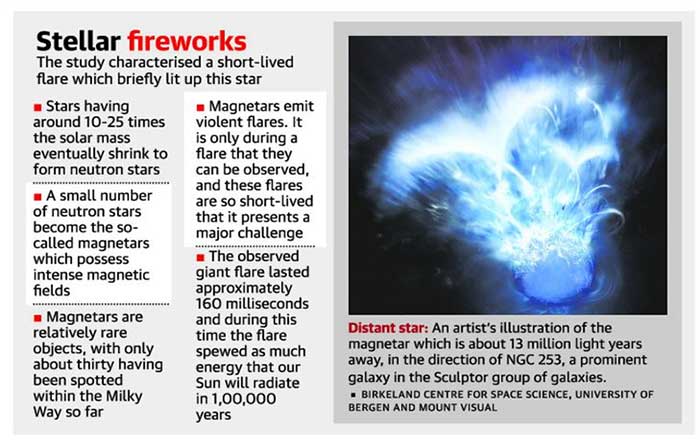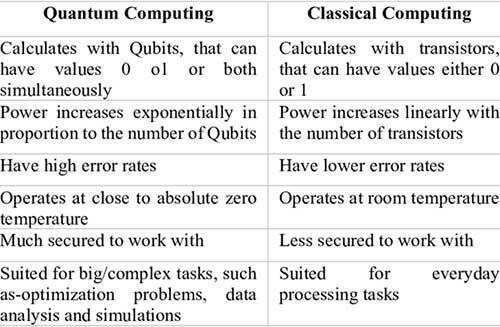Daily Static MCQs Quiz for UPSC, IAS, UPPSC/UPPCS, MPPSC. BPSC, RPSC & All State PSC Exams
Subject : Science and Technology
1. Consider the following statements regarding the phenomenon of Gravitational lensing.
1. Gravitational lensing is opposite to Einstein's theory of
general relativity.
2. A gravitational lens can occur when a huge amount of matter, like a cluster
of galaxies, creates a gravitational field that distorts and magnifies the light
from distant galaxies that are behind it but in the same line of sight.
3. Gravitational lenses act like natural cosmic telescopes.
4. More massive the object, the stronger is its gravitational field.
Which of the above statements is/are correct?
a) 1, 2, 3
b) 1, 2, 4
c) 1, 3, 4
d) 2, 3, 4
Answer: (D)
Explanation:

- The phenomenon of gravitational lensing occurs when a huge amount of matter, such as a massive galaxy, cluster of galaxies or a black hole, creates a gravitational field that distorts and magnifies the light from objects behind it. Hence, statement 2 is correct.
- Gravitational lensing is based on Einstein’s theory of general relativity (Mass bend light). Hence, statement 1 is not correct.
- Normal lenses such as the ones in a magnifying glass work by bending light rays that pass through them in a process known as refraction, in order to focus the light somewhere else.
- Similarly, the gravitational field of a massive object causes light rays passing close to that object to be bent and refocused somewhere else.
- The more massive the object, the stronger its gravitational field and hence the greater the bending of light rays – just like using denser materials to make optical lenses results in a greater amount of refraction. Hence, statement 4 is correct.
- In effect, gravitational lenses act like natural cosmic telescopes. Hence, statement 3 is correct.
Hence, option (d) is correct.
2. Consider the following statements.
1. Massive stars with masses around 10-25 times the mass of
the Sun collapse and shrink to form neutron stars.
2. A small number of neutron stars become magnetars which possess intense
magnetic fields.
3. There are millions of magnetars spotted within the Milky Way Galaxy.
Which of the above statements is/are correct?
a) 1, 3
b) 1, 2
c) 1 only
d) 1, 2, 3
Answer: (B)
Explanation:
How do magnetars form?
During the course of their evolution, massive stars – with masses around 10-25 times the mass of the Sun – eventually collapse and shrink to form very compact objects called neutron stars. A subset of these neutron stars are the so-called magnetars which possess intense magnetic fields. These are highly dense and have breathtakingly high rotation speeds – they have rotational periods that can be just 0.3 to 12.0 seconds.

Note– This picture explains every aspect of the question. Magnetars are relatively rare objects, with only about thirty having been spotted within the Milky Way so far. Hence, statement 3 is not correct while statement 1 and 2 are correct.
Hence, option (b) is correct.
Additional Informations–
What is a Magnetar?
- Magnetars are the most magnetic stars in the universe.
- It is a rare compact type of neutron star teeming with energy and magnetism.
- It is an exotic type of neutron star, its defining feature is that it has an ultra-powerful magnetic field.
- The field is about 1,000 times stronger than a normal neutron star and about a trillion times stronger than the Earth’s.
- Magnetars are relatively rare objects, with only about thirty having been spotted within the Milky Way so far.
What is the recent study?
- The studied magnetar is about 13 million light years away, in the direction of the NGC 253, a prominent galaxy in the Sculptor group of galaxies.
- Its flare spewed within a few tenths of a second as much energy as the Sun would shed in 100,000 years.
- It was captured accidentally on April 15, 2020, by the Atmosphere-Space Interactions Monitor instrument (ASIM) of the International Space Station.
- This is the first study to characterise such a flare from such a distant magnetar.
How do magnetars form?
- During the course of their evolution, massive stars – with masses around 10-25 times the mass of the Sun – eventually collapse and shrink to form very compact objects called neutron stars.
- A subset of these neutron stars is the so-called magnetars which possess intense magnetic fields.
- These are highly dense and have breathtakingly high rotation speeds – they have rotational periods that can be just 0.3 to 12.0 seconds.
What characterises Magnetars?
(1) Violent flares
- The observed giant flare lasted approximately 160 milliseconds and during this time 1039 joules of energy was released.
- The flare spewed as much energy in a tenth of a second that our Sun will radiate in 100,000 years.
(2) Starquakes
- Eruptions in magnetars are believed to be due to instabilities in their magnetosphere, or “starquakes” produced in their crust – a rigid, elastic layer about one kilometre thick.
- This causes waves in the magnetosphere, and interaction between these waves causes dissipation of energy.
3. Consider the following statements.
1. Web 1.0 was the first generation of the global digital
communications network.
2. Web 1.0 is often referred to as “read and write” internet, where users were
able to communicate with servers and other users leading to the creation of the
social web.
3. Web 3.0 is used to refer to the next generation of Internet – a
“read-write-execute” web with decentralization.
Which of the above statements is/are correct?
a) 1 only
b) 1, 2
c) 1, 3
d) 2, 3
Answer: (C)
Explanation:

- Web 1.0 was the first generation of the global digital communications network. It is often referred to as the “read-only” Internet made of static web-pages that only allowed for passive engagement. Hence, statement 1 is correct and statement 2 is not correct.
- The next stage in the evolution of the web was the “read and write”
Internet. Users were now able to communicate with servers and other
users leading to the creation of the social web. This is the world wide
web that we use today.
Web 3.0 is an evolving term that is used to refer to the next generation of Internet – a “read-write-execute” web – with decentralization as its bedrock. Hence, statement 3 is correct. - It speaks about a digital world, built leveraging the blockchain technology, where people are able to interact with each other without the need of an intermediary. Web 3.0 will be driven by Artificial Intelligence and machine learning where machines will be able to interpret information like humans.
4. Consider the following statements regarding Fibre optics technology.
1. The data transmission in fibre optic technology is
performed in the form of light rays.
2. The signal transmission phenomenon of fibre optics is a function of total
internal reflection.
3. Fibre optics are highly sensitive to electromagnetic and radio frequency
interference.
Which of the above statements is/are correct?
a) 1, 2
b) 1, 3
c) 2, 3
d) 1, 2, 3
Answer: (A)
Explanation:
- Fibre optics or optical fibre is a flexible, transparent, glass-drawn strands of micro diameter. The manufacturing material of fibre optic strands can be plastic or glass (Silica) according to the requirement. The optical fibre technology is basically the transmission of light through these thin strands of optical fibre. In this technology, multiple optical fibres are bundled together to form a fibre optic cable for signal transmission purposes. The data transmission in fibre optic technology is performed in the form of light rays. Hence, statement 1 is correct.
- The transmission principle of fibre optics is detailed as follows.
- The signal transmission phenomenon of fibre optics is a function of total internal reflection. Hence, statement 2 is correct.
- Basically, fibre optic transmits data in the form of a photon beam that is a light wave. Reflection and refraction are characteristics of the light wave.
- When the light beam enters the core diameter, it incidents on the core at a small incident angle.
- However, due to the low refractive index of the cladding material,the light beam faces total reflection inside the core. This is called total internal reflection.
- Due to the higher incident angle than the critical angle,the phenomenon of total internal reflection repeats periodically causing the light beam to travel in a zigzag manner.
- By following the total internal reflection several times, the light beam reaches the receiving end of the fibre.
- Fibre optics are highly immune to electromagnetic and radio frequency interference. This helps in uninterrupted signal transmission via fibre optic cables. Hence, statement 3 is not correct.
5. Consider the following statements regarding Quantum Technology.
1. Quantum computers compute in qubits.
2. It has the potential to rapidly accelerate the development of artificial
intelligence.
3. Earthquakes, Tsunamis, drought and floods may become more predictable with
quantum applications.
4. The country's first quantum computing-based telecom network link is now
operational in the national capital.
Which of the above statements is/are correct?
a) 1, 2
b) 2, 3
c) 1, 2, 3
d) 1, 2, 3, 4
Answer: (D)
Explanation:
- Quantum Technology is based on the principles of Quantum mechanics that was developed in the early 20th century to describe nature in the small — at the scale of atoms and elementary particles.
- Conventional computers process information in ‘bits’ or 1s and 0s, following classical physics under which our computers can process a ‘1’ or a ‘0’ at a time.
- Quantum computers compute in ‘qubits’ (or quantum bits). They exploit the properties of quantum mechanics, the science that governs how matter behaves on the atomic scale. Hence, statement 1 is correct.
What can quantum computers do?
- Quantum computers aren’t just about doing things faster or more efficiently. They’ll let us do things that we couldn’t even have dreamed of without them. Things that even the best supercomputer just isn’t capable of. They have the potential to rapidly accelerate the development of artificial intelligence. Google is already using them to improve the software of self-driving cars. They’ll also be vital for modelling chemical reactions. Hence, statement 2 is correct.
- Tsunamis, drought, earthquakes and floods may become more predictable with quantum applications. The collection of data regarding climate change can be streamlined in a better way through quantum technology. This in turn will have a profound impact on agriculture, food technology chains and the limiting of farmland wastage. Hence, statement 3 is correct.
- The country's first quantum computing-based telecom network link is now operational in the national capital. Hence, statement 4 is correct.
Hence, option (d) is correct.
Difference between Quantum Computing and Classical Computing








